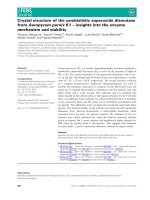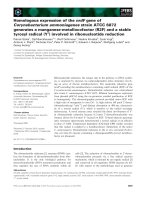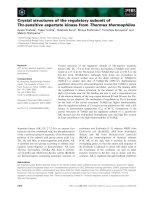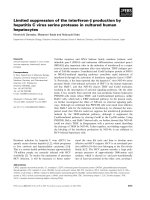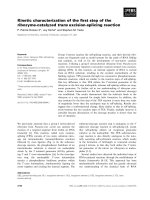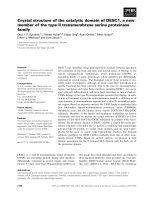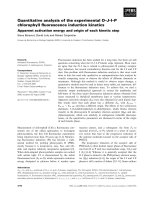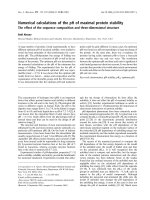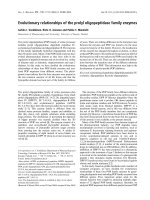Báo cáo khoa hoc:" Posterior dislocation of the elbow as an unusual presentation after a total hip replacement: a case report" pdf
Bạn đang xem bản rút gọn của tài liệu. Xem và tải ngay bản đầy đủ của tài liệu tại đây (1.33 MB, 4 trang )
BioMed Central
Page 1 of 4
(page number not for citation purposes)
Journal of Medical Case Reports
Open Access
Case report
Posterior dislocation of the elbow as an unusual presentation after
a total hip replacement: a case report
Kumar Periasamy*, Dominic Meek and Paul Crossman
Address: Department of Orthopaedics and Trauma surgery, Southern General Hospital, Glasgow, UK
Email: Kumar Periasamy* - ; Dominic Meek - ;
Paul Crossman -
* Corresponding author
Abstract
Introduction: Posterior dislocation of the elbow is usually associated with trauma to the joint
with a reported incidence of 3%to 6%. Chronic instability is usually symptomatic following the initial
injury.
Case presentation: We report a case of posterior dislocation of the elbow occurring in a patient
while using her arm to lift herself using a monkey pole on the second day following a total hip
replacement. The dislocation was reduced under sedation in the ward. There were no signs or
symptoms suggesting any joint hypermobility syndrome in the patient. Follow up 4 months
following the injury revealed a complete recovery in the range of motion and a pain free elbow.
There were no signs and symptoms of any instability.
Conclusion: This is the first time such a case is reported in the literature. It certainly
demonstrates that even in the absence of instability a patient can be predisposed to low energy
dislocation of the elbow.
Introduction
Posterior dislocation of elbow is infrequent but not
uncommon [1]. Elbow dislocation is the second most
common type of dislocation encountered in the adult
population. The majority of these can be treated by closed
manipulation and relocation [2]. It is well recognized that
simple dislocations are commonly associated with good
outcomes after a closed reduction and institution of early
motion [3].
We report an unusual case of posterior dislocation of an
elbow in an adult while trying to get out of bed using a
monkey pole on the second post operative day after a hip
replacement.
This is the first case to be reported in the literature with
such an unusual mechanism
Case presentation
A 27 year woman, previously fit and healthy, who has
congenital arteriovenous malformations localised to the
right lower limb was seen in the orthopaedic clinic with a
painful right hip. Assement of her hip confirmed a
severely arthritic hip with radiological features of second-
ary arthritis associated with developmental dysplasia of
the hip joint. She underwent an elective total hip replace-
ment (Figure 1 and 2).
Surgery was performed routinely. While undertaking
standard mobilisation, the patient was trying to get out of
Published: 6 February 2008
Journal of Medical Case Reports 2008, 2:38 doi:10.1186/1752-1947-2-38
Received: 16 October 2007
Accepted: 6 February 2008
This article is available from: />© 2008 Periasamy et al; licensee BioMed Central Ltd.
This is an Open Access article distributed under the terms of the Creative Commons Attribution License ( />),
which permits unrestricted use, distribution, and reproduction in any medium, provided the original work is properly cited.
Journal of Medical Case Reports 2008, 2:38 />Page 2 of 4
(page number not for citation purposes)
her bed on the second day post operation, heared a pop
and presented with a painful deformed elbow on the left
side
Patient was reviewed by the upper limb consultant who
was on call. A posterior elbow dislocation was diagnosed
and reduced on the ward under intravenous sedation. X
ray of the dislocated elbow was not performed in view of
the pain and the obvious clinical appearance confirming
the diagnosis.
A check x-ray following the reduction confirmed reloca-
tion of the elbow joint and minor ectopic calcification in
the lateral joint region of the elbow (Figure 3 and 4)
On further questioning the patient and her parents, they
recollected that the patient had dislocated the same elbow
at an age of 9 years and was reduced in the Accident and
Emergency.
She did not have any residual effect of elbow instability
prior to the present episode of dislocation and any evi-
dence of generalised ligamentous laxity.
AP xray ElbowFigure 3
AP xray Elbow.
Post op PelvisFigure 2
Post op Pelvis.
Pre op PelvisFigure 1
Pre op Pelvis.
Journal of Medical Case Reports 2008, 2:38 />Page 3 of 4
(page number not for citation purposes)
Discussion
Elbow dislocation is not a frequently seen condition and
is usually associated with significant trauma as it is an
inherently stable joint. When an isolated dislocation of
the elbow occurs without fracture, closed reduction of the
elbow with early mobilization (within 2 weeks) results in
a stable joint with good functional outcome [4].
With regard to the anatomy of the elbow, stability is
afforded by both static and dynamic structures. Static
structures include the complex bony architecture and soft-
tissue stabilizers. The static soft-tissue stabilizers consist of
the anterior and posterior joint capsule and both medial
and lateral collateral ligament complexes. Of the liga-
ments around the elbow the lateral collateral ligament
complex (LCLC) is defined as the Lateral collateral liga-
ment (LCL) with its ulnar and radial components and the
annular ligament. The lateral ulnar collateral ligament
(LUCL) is described as a discrete part of the LCLC that
serves to prevent postero lateral rotatory instability and
varus stress [5].
O'Driscoll et al [6] anatomically defined this LUCL from
its common insertion with the LCLC on the lateral epi-
condyle to its isolated insertion at the tubercle on the
supinator crest. The function of the LCLC and the impor-
tance of each component and the surrounding soft tissues
and the mechanism of poster lateral rotatory instability
(PLRI) continue to be investigated and debated. Addi-
tional stability is conferred by dynamic structures-the
muscles crossing the elbow joint [6].
Recent studies continue to develop our understanding of
the role and importance of the primary and secondary sta-
bilizers of the elbow.
Disruption or attenuation of LCL structures is associated
with elbow dislocation, varus stress, and iatrogenic causes
and patients may present with complaints of catching,
clicking, instability, such as Posterolateral rotatory insta-
bility (PLRI), or recurrent dislocation
Dislocation of the previously stable elbow, for example,
while trying to get out of bed is a rather unusual mecha-
nism. It might suggest that the elbow had a degree of
instability but the patient denied having any significant
problems with the elbow prior to the incident.
In addition it might be expected that the patient would
have generalised ligamentous laxity but our patient did
not have any laxity according to Beighton's criteria [7] for
ligamentous laxity.
Elbow dislocation has been described in a child treated
with overhead traction for supracondylar fracture after
closed reduction [8]. In this case the anterior capsular rup-
ture during the time of fracture was thought to be the pre-
cipitating factor while on traction. However in our case
the anterior capsule would not have been acutely dis-
rupted.
Rasool et al reviewed 33 children with dislocated elbow
with a mean of 10 months (4 to 48) and found no case of
recurrence indicating that children do well following this
type of injuries [1].
Lateral xray ElbowFigure 4
Lateral xray Elbow.
Publish with BioMed Central and every
scientist can read your work free of charge
"BioMed Central will be the most significant development for
disseminating the results of biomedical research in our lifetime."
Sir Paul Nurse, Cancer Research UK
Your research papers will be:
available free of charge to the entire biomedical community
peer reviewed and published immediately upon acceptance
cited in PubMed and archived on PubMed Central
yours — you keep the copyright
Submit your manuscript here:
/>BioMedcentral
Journal of Medical Case Reports 2008, 2:38 />Page 4 of 4
(page number not for citation purposes)
Conclusion
Our patient is of interest as there is no previously reported
case in the literature of such a late low energy dislocation.
It suggests that in children if there is a failure of the cap-
sule and ligamentous structures to become correctly reat-
tached after traumatic dislocation it may predispose to
further dislocation from low energy trauma. It certainly
demonstrates that even in the absence of instability a
patient can be predisposed to low energy dislocation of
the elbow.
Abbreviations
PLRI – Poster lateral rotatory instability; LCLC – Lateral
collateral ligament complex; LUCL – Lateral ulnar collat-
eral ligament
Competing interests
No benefits in any form have been received or will be
received from a commercial party related directly or indi-
rectly to the subject of this article
Authors' contributions
KP - reporting the case, including literature search. PC -
Consultant (Upper limb specialist) who diagnosed and
reduced the elbow. DM - Supervising consultant. All
authors read and approved the final manuscript.
Consent
Written informed consent was obtained from the patient
for publication of this Case report and any accompanying
images. A copy of the written consent is available for
review by the Editor-in-Chief of this journal.
References
1. Rasool MN: Dislocations of the Elbow in children. Journal of
Bone & Joint Surgery British 2004, 86-B(7):1050-1058.
2. Hankin FM: Posterior dislocation of the elbow: A simplified
method of closed reduction. Clinical Orthopaedics and Related
Research Number 190 1984:254-256.
3. Mudgal , Chaitanya S, Jupiter , Jesse BMD: New Concepts in dislo-
cations of the Elbow Techniques in Orthopaedics. Surgical
Management of Complex elbow Problems: Update 2006 2006,
21(4):347-362.
4. Mehlhoff TL, Noble PC, Bennett JB, Tullos HS: Simple dislocation
of the elbow in the adult. Results after closed treatment. J
Bone Joint Surg Am 1988, 70:244-249.
5. Flanigan , Clint David, Kaplan , Lee D: Elbow dislocations and
instability. Current Opinion in Orthopedics 2004, 15(4):280-285.
6. O'Driscoll SWEH, Morrey BFSWC: Anatomy of the ulnar part of
the lateral collateral ligament of the elbow. Clin Anat 1992,
5:296-303.
7. Beighton PH, Solomon L, Soskolone CL: Articular mobility in an
African population. Am Rheum Dis 1973, 32:413-18.
8. Arthur Heilbronner, Arthur Manoli, Ronald Little: Elbow disloca-
tion during overhead skeletal traction, A case report; Clini-
cal Orthopaedics And Related Research Number 154,
January–Feburary 1981. .
